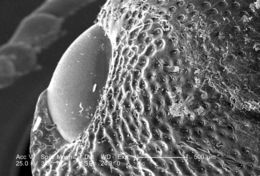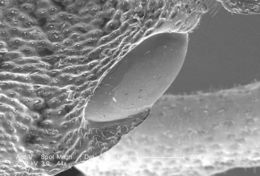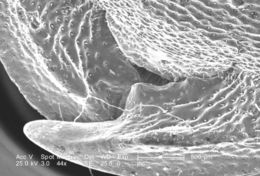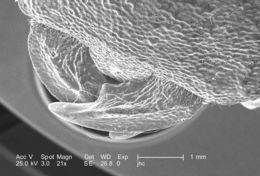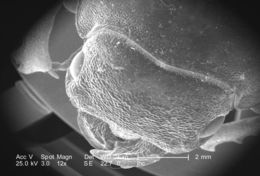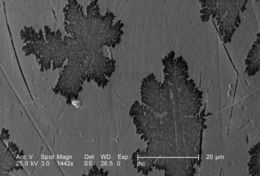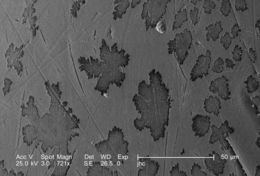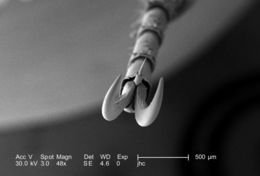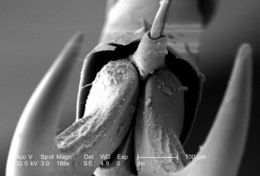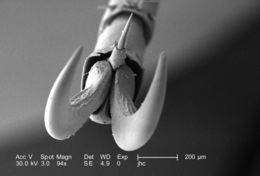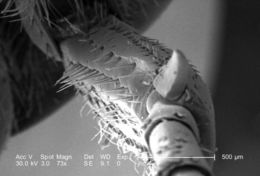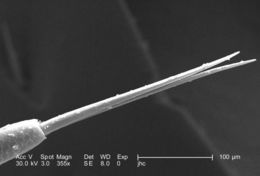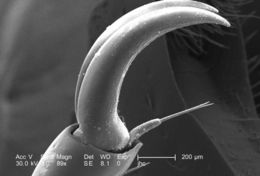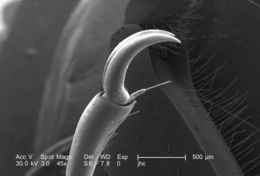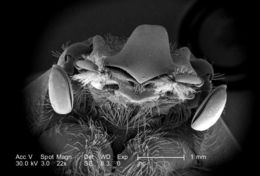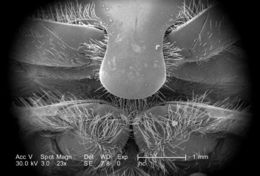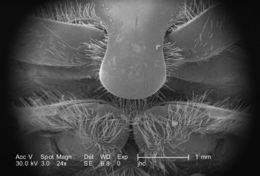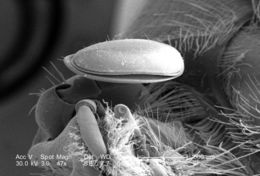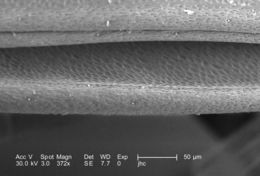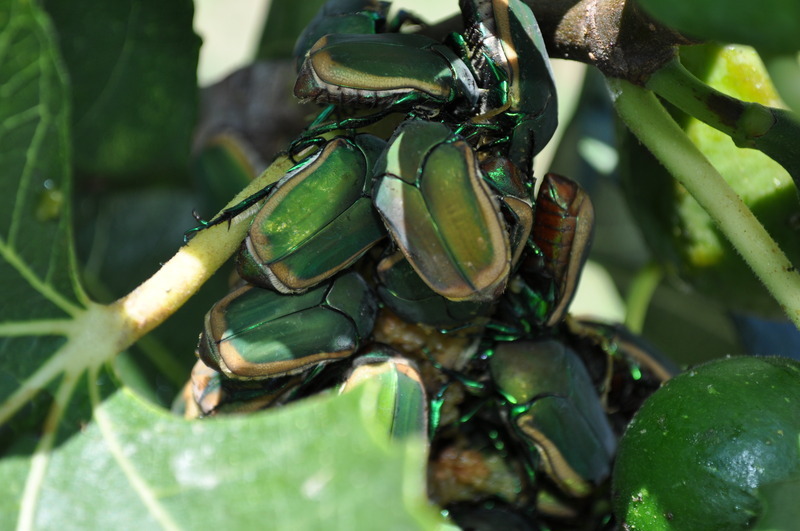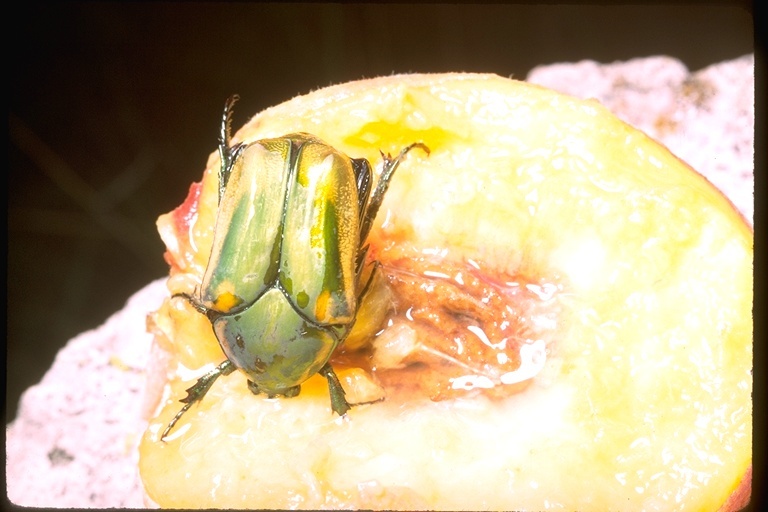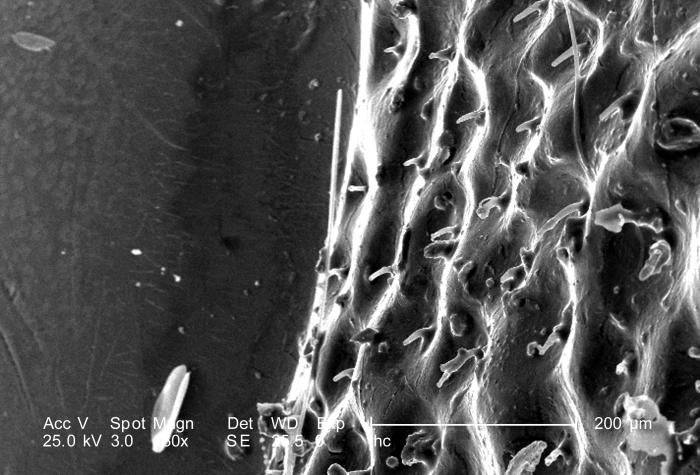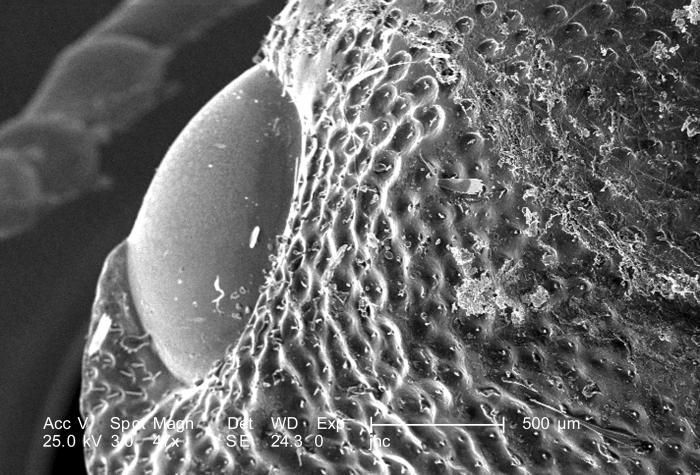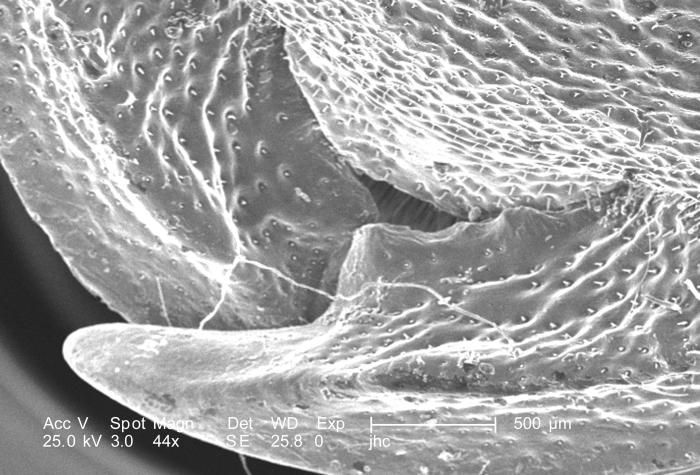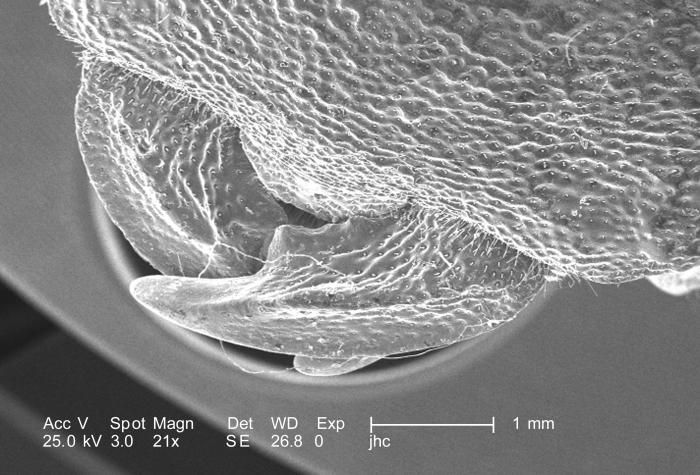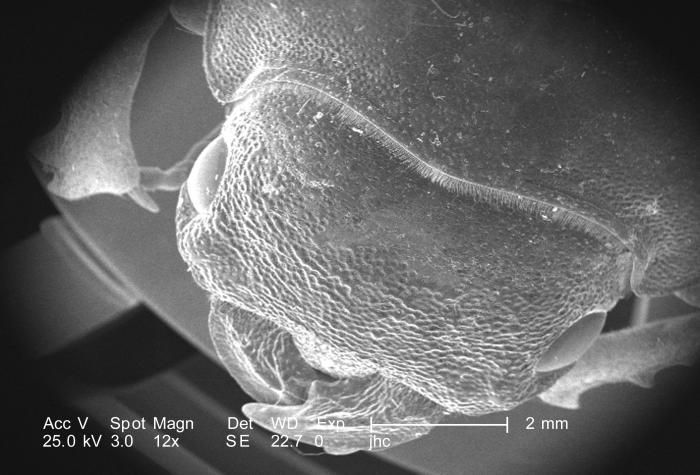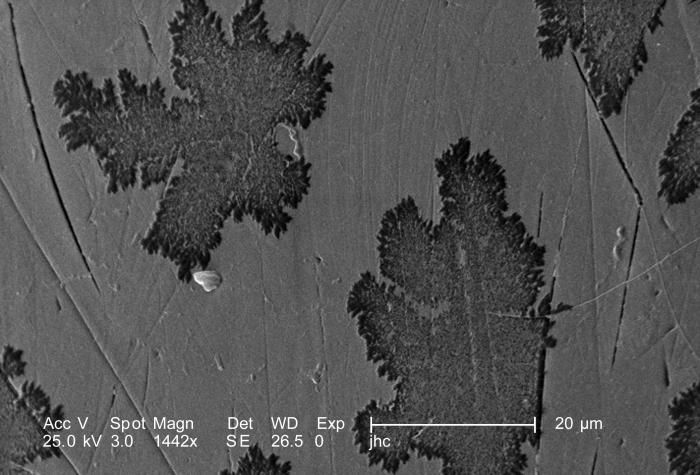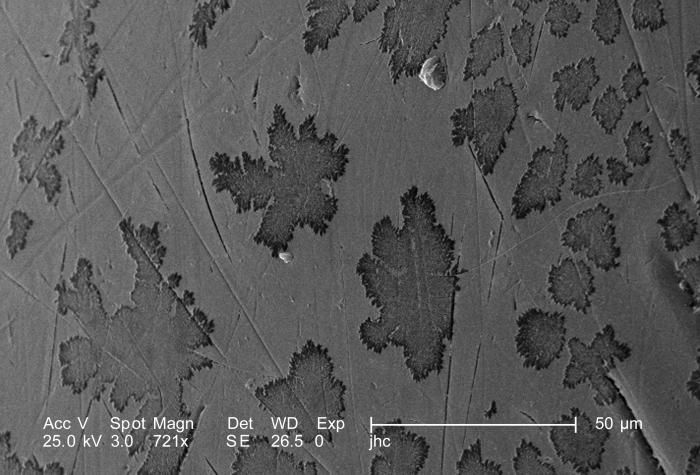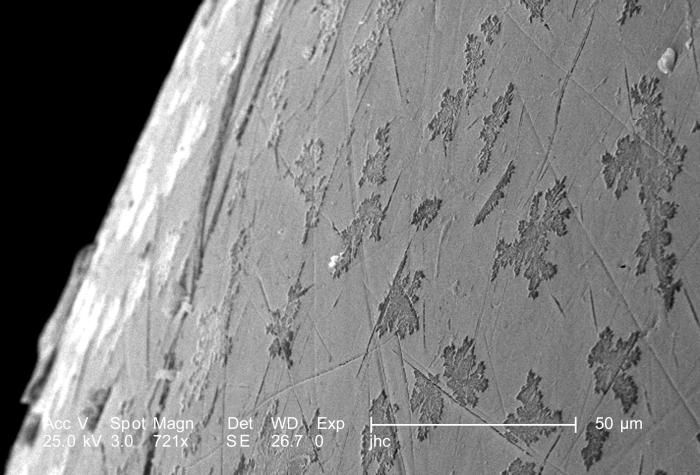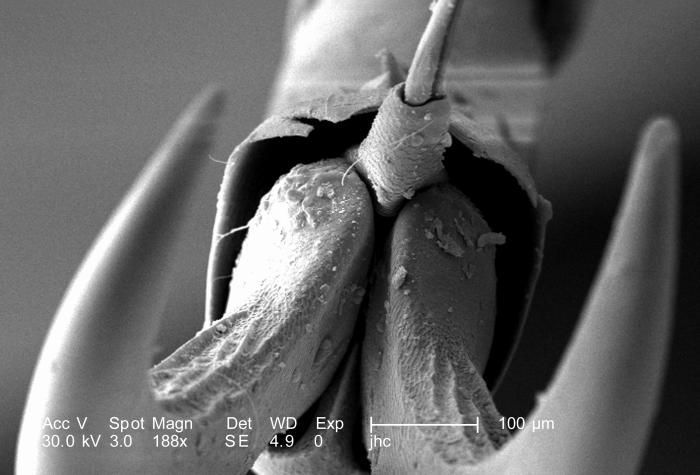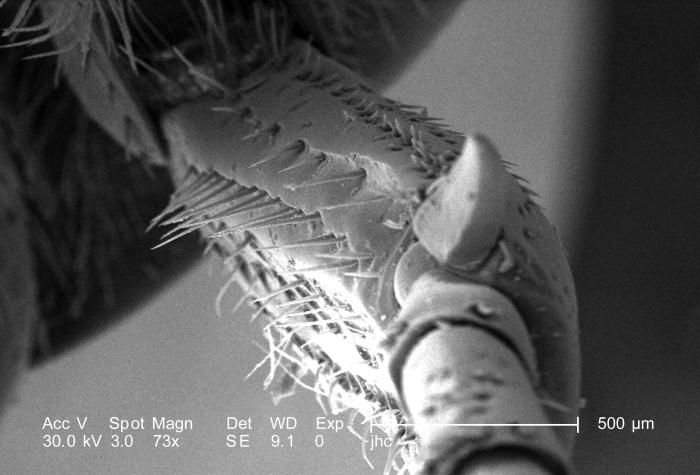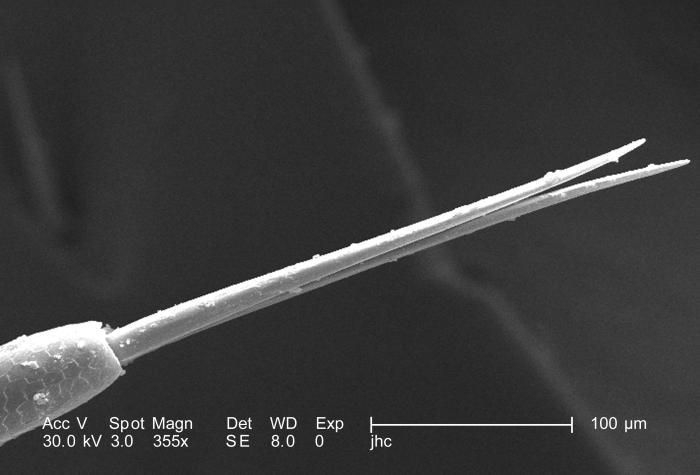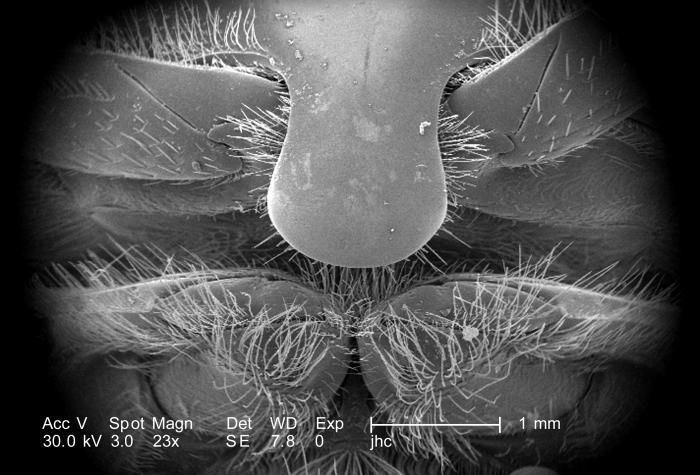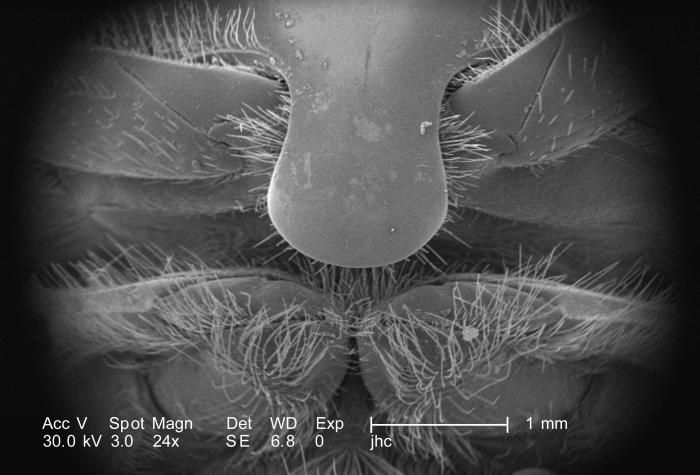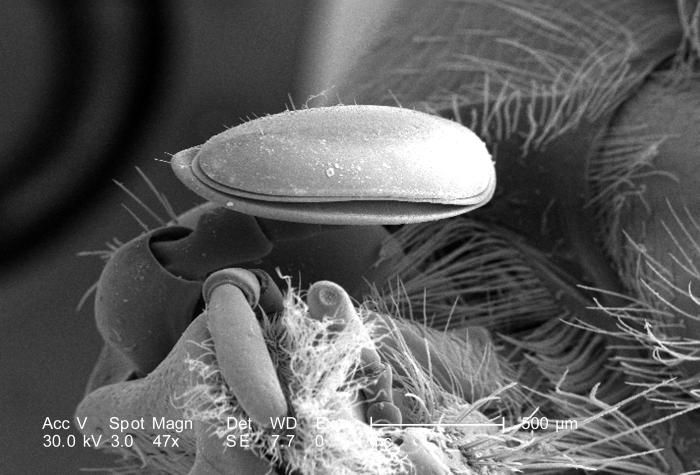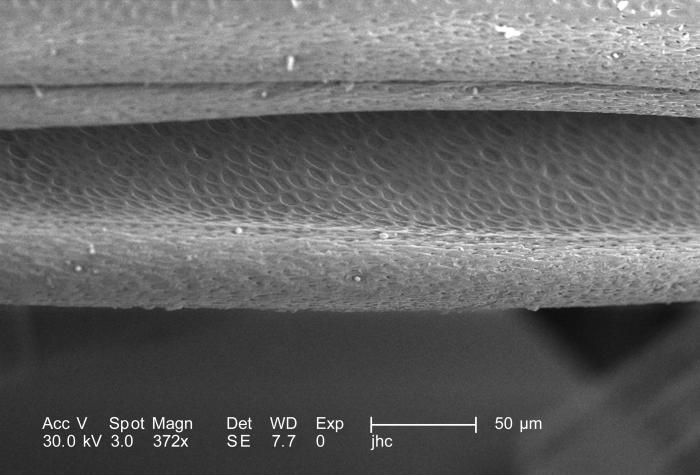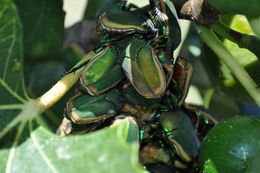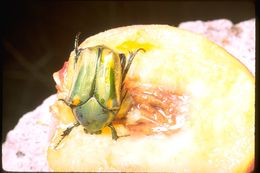-
Recorded/photographed #1, 24 beetles upon a single fig.
-
Close up of June beetles on a single fig fruit. Refer to photograph #1 DSC_0259.JPG.
-
2005 California Academy of Sciences
CalPhotos
-
At a magnification of 130X, this scanning electron micrograph (SEM) focused on the head region of an adult figeater beetle, Cotinis mutabilis. In this particular view, the transitional area between one of the insects two compound eyes, i.e., right eye, and the vertex of its head is visualized. For even greater magnifications of the surface of the eye, see PHIL 9950, 9951, and 9952.Created: 2007
-
At a low magnification of 47X, this scanning electron micrograph (SEM) focused on the head region of an adult figeater beetle, Cotinis mutabilis. In this particular view, one of the insects two compound eyes, i.e., right eye, is visualized. For even greater magnifications of the surface of the eye, see PHIL 9950, 9951, and 9952.Created: 2007
-
At a low magnification of 44X, this scanning electron micrograph (SEM) focused on the head region of an adult figeater beetle, Cotinis mutabilis. In this particular view, one of the insects two compound eyes, i.e., left eye, is visualized. For even greater magnifications of the surface of the eye, see PHIL 9950, 9951, and 9952.Created: 2007
-
At a low magnification of 44X, this scanning electron micrograph (SEM) focused on the head region of an adult figeater beetle, Cotinis mutabilis. Note the insects two overlapping mandibles. For successively greater magnifications of this region with its exoskeletal features PHIL 9953, 9954, 9956, 9957 and 9958.Created: 2007
-
At a low magnification of 21X, this scanning electron micrograph (SEM) focused on the head region of an adult figeater beetle, Cotinis mutabilis. Note the insects two overlapping mandibles. For successively greater magnifications of this region with its exoskeletal features PHIL 9953, 9955, 9956, 9957 and 9958.Created: 2007
-
At a very low magnification of 12X, this scanning electron micrograph (SEM) focused on the head region of an adult figeater beetle, Cotinis mutabilis. Note the two laterally-positioned eyes, as well as the insects overlapping mandibles. For successively greater magnifications of this region with its exoskeletal features PHIL 9954, 9955, 9956, 9957 and 9958.Created: 2007
-
Magnified 1442X, twice that of PHIL 9950 and 9951, this scanning electron micrograph (SEM) revealed some of the ultrastructural details found on the surface of one of the two eyes of this adult figeater beetle, Cotinis mutabilis. The meaning behind the leaf-like pattern seen on the eyes chitinous surface is unknown, however, when carefully scrutinized, it does not appear to be randomized.Created: 2007
-
Magnified 721X, this scanning electron micrograph (SEM) revealed some of the ultrastructural details found on the surface of one of the two eyes of this adult figeater beetle, Cotinis mutabilis. The meaning behind the leaf-like pattern seen on the eyes chitinous surface is unknown, however, when carefully scrutinized, it does not appear to be randomized. Note PHIL 9950 and 9952 for other views of this configuration.Created: 2007
-
Magnified 721X, this scanning electron micrograph (SEM) revealed some of the ultrastructural details found on the surface of one of the two eyes of this adult figeater beetle, Cotinis mutabilis. The meaning behind the leaf-like pattern seen on the eyes chitinous surface is unknown, however, when carefully scrutinized, it does not appear to be randomized. Note PHIL 9951 and 9952 for other views of this configuration.Created: 2007
-
At a magnification of 188X, half that of PHIL 9947, this scanning electron micrograph (SEM) depicted a head-on view of the distal clawed tip of an adult figeater beetles, Cotinis mutabilis leg. Phil 9943, 9944, and 9945 depict this anatomical appendicular relationship from its side. The insect leg is comprised of a variable number of segments, however, there are usually six which predominate, including the most proximal coxa, i.e., attaching the leg to the thorax, followed by the trochanter, femur, tibia, tarsus, and pretarsus, which in the case of this beetle is a claw with its spiked empodium.Created: 2007
-
At a magnification of 188X, twice that of PHIL 9947, this scanning electron micrograph (SEM) depicted a head-on view of the distal clawed tip of an adult figeater beetles, Cotinis mutabilis leg. Phil 9943, 9944, and 9945 depict this anatomical appendicular relationship from its side. The insect leg is comprised of a variable number of segments, however, there are usually six which predominate, including the most proximal coxa, i.e., attaching the leg to the thorax, followed by the trochanter, femur, tibia, tarsus, and pretarsus, which in the case of this beetle is a claw with its spiked empodium.Created: 2007
-
At a low magnification of 94X, this scanning electron micrograph (SEM) depicted a head-on view of the distal clawed tip of an adult figeater beetles, Cotinis mutabilis, leg. Phil 9943, 9944, and 9945 depict this anatomical appendicular relationship from its side. The insect leg is comprised of a variable number of segments, however, there are usually six which predominate, including the most proximal coxa, i.e., attaching the leg to the thorax, followed by the trochanter, femur, tibia, tarsus, and pretarsus, which in the case of this beetle is a claw with its spiked empodium.Created: 2007
-
Under a low magnification of only 73x, this scanning electron micrograph (SEM) depicted the region of one of the legs of an adult figeater beetles, Cotinis mutabilis, leg, which included the tibiotarsal joint in the background, and the tarsopretarsal joint in the foreground. The numerous hairs, or setae, adorning almost all of the insects exterior surfaces, act as sensory structures, supplying the organism with information about its environmental parameters.Created: 2007
-
At an even higher magnification of 355X, which is twice as high as PHIL 9944 and four time greater than PHIL 9943, this scanning electron micrograph (SEM) again depicted some of the morphologic exoskeletal features located at the distal end of an adult figeater beetles, Cotinis mutabilis leg. Depicted here was a closer view of the tarsal empodium, which is a spike or bristle that arises from the last tarsal segment from what is known as the unguitrator plate. This chitinous structure enhances the claw-like appendicular configuration, which is better visualized in PHIL 9943 and 9944, and affords the beetle a more secure grasp of objects within its environmental domain, such as foliage or food. See PHIL 9943, 9944, 9947, 9948, and 9949 for additional views of these exoskeletal features.Created: 2007
-
Still at a low magnification of 89X, which is twice as high as PHIL 9943, this scanning electron micrograph (SEM) again depicted some of the morphologic exoskeletal features located at the distal end of an adult figeater beetles, Cotinis mutabilis leg. Depicted here was the claw-like tip of the insects 5th tarsomere, as well as its accompanying empodium. This appendicular configuration affords the beetle a secure grasp of objects within its environmental domain, such as foliage or food. See PHIL 9943, 9945, 9947, 9948, and 9949 for additional views of these exoskeletal features.Created: 2007
-
At a low magnification of only 45X, this scanning electron micrograph (SEM) depicted some of the morphologic exoskeletal features located at the distal end of an adult figeater beetles, Cotinis mutabilis leg. Depicted here was the claw-like tip of the insects 5th tarsomere, as well as its accompanying empodium. This appendicular configuration affords the beetle a secure grasp of objects within its environmental domain, such as foliage or food. See PHIL 9944, 9945, 9947, 9948, and 9949 for additional views of these exoskeletal features.Created: 2007
-
At a low magnification of only 22X, this scanning electron micrograph (SEM) depicted some of the morphologic exoskeletal features located on the head region of an adult figeater beetle, Cotinis mutabilis. Sometimes referred to as a junebug, this insect is a member of the taxonomic family, Scarabaeidae, or dung beetles. Note the pair of lamellate, bilaterally-situated antennae, which are in a folded position.Created: 2007
-
Under a low magnification of only 23x, this scanning electron micrograph (SEM) depicted some of the anatomical relationships found on the ventral surface of this adult figeater beetles, Cotinis mutabilis thorax, which is the body region situated between the insects head and abdomen. In this particular view, two of the three pairs of legs may be seen emanating adjacent to the prosternal process, which is a posterior extension of the sternum. The insect leg is comprised of a variable number of segments, however, there are usually six which predominate, including the most proximal, i.e., attaching the leg to the thorax, coxa, followed by the trochanter, femur, tibia, tarsus, and pretarsus, which in the case of this beetle is a claw, well visualized in PHIL 9943, 9944, and 9945.Created: 2007
-
Under a low magnification of only 24x, this scanning electron micrograph (SEM) depicted some of the anatomical relationships found on the ventral surface of this adult figeater beetles, Cotinis mutabilis thorax, which is the body region situated between the insects head and abdomen. In this particular view, two of the three pairs of legs may be seen emanating adjacent to the prosternal process, which is a posterior extension of the sternum. The insect leg is comprised of a variable number of segments, however, there are usually six which predominate, including the most proximal, i.e., attaching the leg to the thorax, coxa, followed by the trochanter, femur, tibia, tarsus, and pretarsus, which in the case of this beetle is a claw, well visualized in PHIL 9943, 9944, and 9945.Created: 2007
-
Magnified 47X, approximately one eighth that of PHIL 9938, this scanning electron micrograph (SEM) revealed morphologic details found at the distal tip of this adult figeater beetles, Cotinis mutabilis, antenna. Known as a lamellate type of antennae, the distal three sensorial segments have been folded over one another, which can be seen here in this image. This morphology is typically found in members of the family Scarabaeidae.The antennae provide the insect with data indicative of changes encountered in its environment such as chemical, thermal, and tactile queues.Created: 2007
-
Magnified 372X, approximately eight times greater than PHIL 9939, this scanning electron micrograph (SEM) revealed morphologic details found at the distal tip of this adult figeater beetles, Cotinis mutabilis, antenna. Known as a lamellate type of antennae, the distal three sensorial segments have been folded over one another, which can be seen here in this image. This morphology is typically found in members of the family Scarabaeidae.The antennae provide the insect with data indicative of changes encountered in its environment such as chemical, thermal, and tactile queues.Created: 2007



